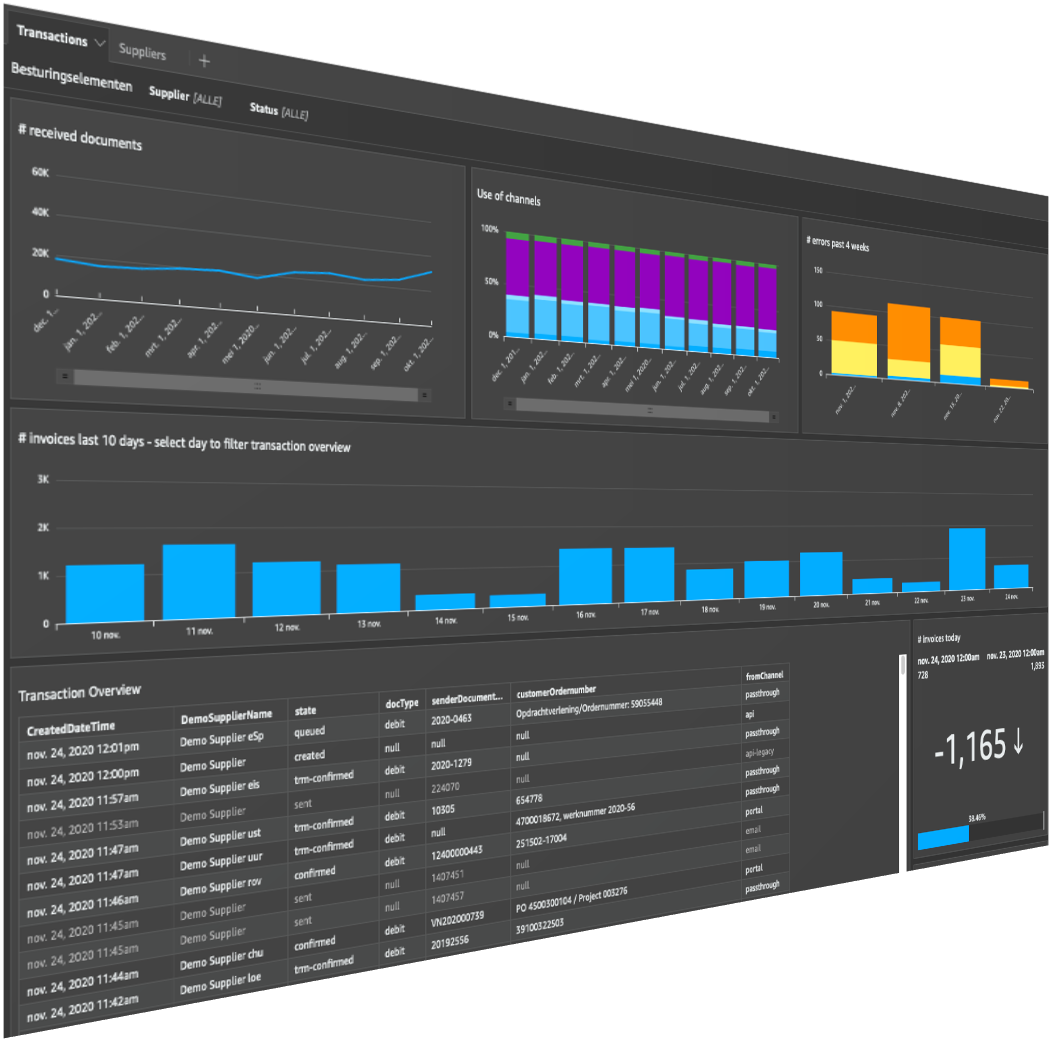Jan Kruijdenberg at Bidfood:
‘With UBL invoices, we offer customisation for every customer’
Online catering wholesaler Bidfood switched to tradeinterop’s services for e-invoicing at the end of last year. ‘Until then, e-invoicing went through different ways with us. We wanted to get more alignment in that. Now we are a few months down the line and everything is running smoothly. The great thing is that more and more of our customers now also want to switch to e-invoicing, which generates enormous efficiency benefits,’ says Jan Kruijdenberg, senior business consultant at Bidfood.
What is Bidfood and who are your customers?
‘Bidfood is an online catering wholesaler with 17 branches in the Netherlands and a total of over 2,000 employees. With some six to seven hundred trucks, we supply both large and small catering establishments, as well as wholesale customers such as hospitals and caterers. I myself have been with this company, and its predecessors from which Bidfood emerged from collaborations, for 40 years. We are an international organisation operating in 35 countries.’
What differentiates you from other catering wholesalers?
‘There are four major catering wholesalers in the Netherlands, of which we are one. Besides our product range and our personalised approach, our competitive strength lies in our digital approach with a webshop that displays our available stock in real time. What you see is what you get, in other words: what you order from us is also available for immediate delivery. In our business, the logistical availability of products – especially fresh products – is really key. We are very good at that. We always deliver. We live up to this every day as our systems are fully integrated with many customers’ ordering systems.’
So how does ordering work?
‘Integration between systems is possible if the kitchen of a restaurant, for example, is fully automated. At the end of the day, it is then clear at a detailed level exactly how many ingredients and products they have used. Suppose they sold 100 satay meals, consisting of three satay sticks, with the garnish including five slices of cucumber. The ordering system then automatically calculates how many cases of cucumbers to order from Bidfood for the next day. And so it goes with every product.’
After that, how is the billing done?
‘The sophistication of the ordering process also applies to billing. This is because it has been grafted onto e-invoicing as much as possible, which has further promoted integration with the customer’s administrative process. In this way, with an electronic invoice, we exchange as much data as possible with the customer’s accounting system. The customer can then automatically book our invoice correctly. As a result, the customer’s administrative process is many times more efficient. We recently optimised this entire process in collaboration with tradeinterop.’
How did you get in touch with tradeinterop?
‘With larger customers, we had already gained a lot of experience with e-invoicing. We also serve government agencies that have this as an obligation for suppliers. However, our problem was that we had specific agreements with many customers on how to prepare these e-invoices. In that, we wanted to get more alignment. Besides, technically in our system we had the problem that we could not link a PDF invoice directly to the e-invoice. At the same time, we had more and more customers who also wanted to switch to e-invoicing, but each time had specific concerns; they were all small business cases. So flexibility was crucial for us to standardise the e-invoicing process as much as possible. In short, we had quite a few challenges. I then went out and researched a few companies. In the end, I came across tradeinterop as the partner who could solve all my problems.’

Broadly speaking, what was the solution?
‘In a word, UBL, which stands for Universal Business Language, a kind of Esperanto in the world of invoicing. Nowadays, if you can provide a UBL invoice, your buyers will be very happy, because most software is able to read such an invoice easily automatically. Whether you have software from Exact, Afas or another accounting system, they usually have a connector to UBL. And then it doesn’t matter whether you have a hundred thousand euro turnover or 10 million euro.’
How many customers use e-invoicing?
‘Until a few years ago, we invoiced with a pdf invoice for 66 percent of our customers and 30 percent went through e-invoicing. Since we partnered with tradeinterop at the end of last year, e-invoicing has increased dramatically. My expectation is that within not too long, 50 percent of all invoices will be done via e-invoicing.’
How is the cooperation with tradeinterop going?
‘We give tradinterop the invoice information. They will receive the xml, the pdf and information about the guidance. That information consists of ‘dumb’ data which tradeinterop then turns into smart data, in accordance with our agreements. We also provide as much data as possible, such as customer identification, cost centre, fixed reference for an annual contract, orderer’s name, you name it. Then, each customer can give their own interpretation to this data. One person uses one element, another uses three and another uses five, which is all very flexible. That’s all in the UBL invoice. In this way, a good connection is always established between the customer and ourselves, making the integration of billing perfect.’
How does an e-invoice reach a customer?
‘From all the components we provide, tradeinterop creates the UBL invoice and sends it directly to the customer or to the Peppol network; which is the large electronic mailbox system that automatically delivers the e-invoice to the customer’s accounting system. What is also possible is that we get the invoice back on our server first and then send it directly to the customer via our connection. Which route the invoice takes depends on specific circumstances of the customer, for example, because the customer does not want to receive the invoices through Peppol but through their own network. We set what the best route is for a specific customer in advance. That is the flexibility I was looking for and found at tradeinterop.’
Could you have built such a system yourself?
‘Yes indeed, only then we would have spent some time on that. We should have studied how everything works together not to mention the laws and regulations underlying this way of billing. So I am very happy to have a specialist like tradeinterop. They are also constantly creating new, even more advanced versions so it is always up-to-date. We pay a monthly fee for that service and don’t really have to worry about it. In the beginning, we had to fine-tune a few things, but with the help of dashboard tooling from tradeinterop, all teething problems were quickly identified and resolved.’

What is dashboardtooling?
‘That is a tool developed by tradeinterop. In it, we can see which invoices have been offered to our customers; which have gone well and which have not. In case of the latter, we pick them up, investigate what caused it and then adjust it. It is a learning process, first together with tradeinterop and nowadays we actually solve everything ourselves through a few minor adjustments.’
How did the whole implementation go?
‘Very good, even given the circumstances. There was a lot of time pressure because we had been let down by another party and a solution had to be found quickly. Tradeinterop handled that well and they helped us out immediately. What did help is that we knew exactly how we wanted it because we have been working on this project for years. Tradeinterop responded well to this and helped us streamline and perfect the whole process.’
Finally, what do you think the world of e-invoicing will look like in five years’ time?
‘We have already carried out a lot of chain integrations in recent years and made a good administrative connection with our customers. This will also be further structured in the coming years. In the process, invoice matching systems will continue to improve and therefore become more efficient. I therefore expect more and more organisations to embrace e-invoicing in the coming years, as it increasingly provides both customers and suppliers with management information needed to stay ahead in the competitive field. If, as an organisation, you catch on to these developments too late, you might miss the boat.’
In short
Problem
Specific arrangements have been made for each customer to whom Bidfood wants to send an e-invoice. They are all small business cases.
Solution
Streamlining e-invoicing so that Bidfood can send the same type of e-invoice to every customer. By switching to UBL invoicing, this is now possible.
Result
By adding smart data in every UBL invoice, it is possible for every customer to connect to Bidfood’s e-invoice and incorporate it directly into the internal administrative process.



